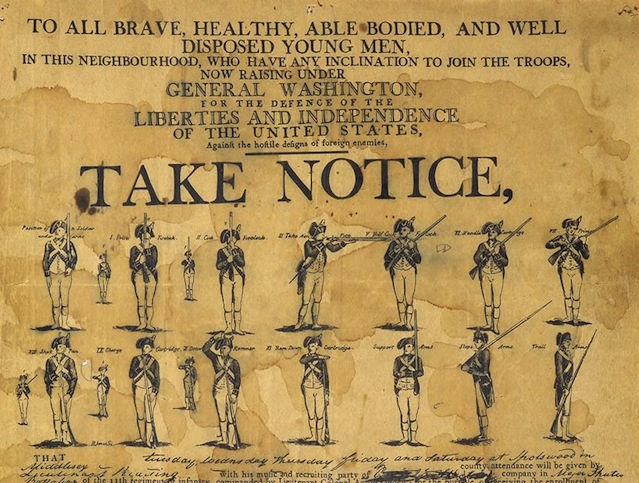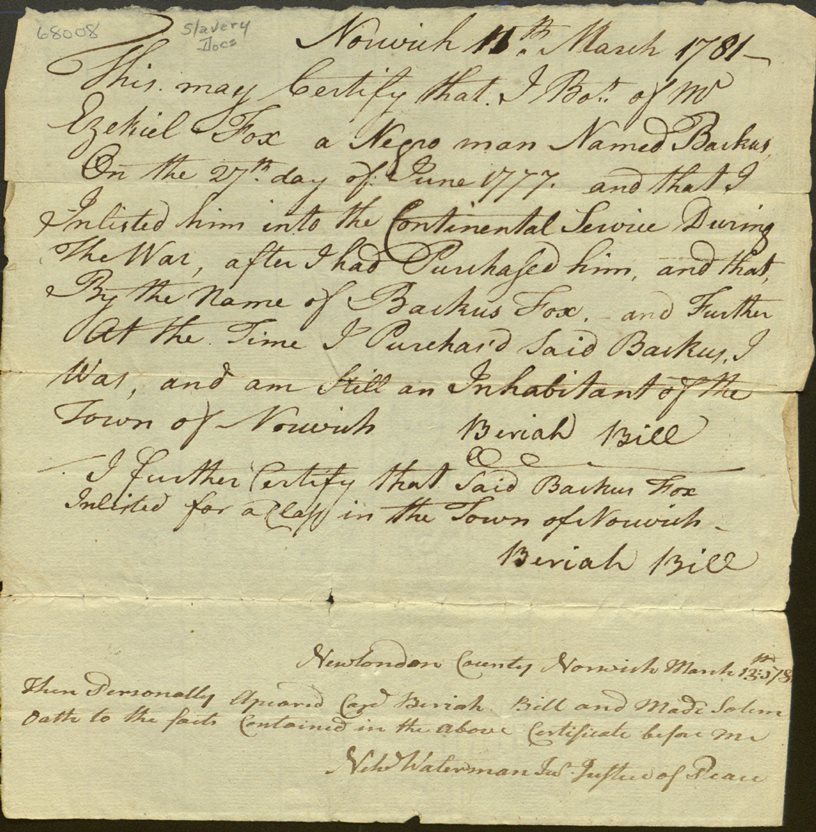TEACHER'S SNAPSHOT
Subjects:
African Americans, Colonial History, Individuals in History, Military Service, Patriotism, Revolutionary War, Slavery & Abolition
Course Topics/Big Ideas:
Role of Connecticut in U.S. History
ESSENTIAL QUESTION
SUPPORTING QUESTIONS
- How did the Continental army get recruits to join?
- Why would a young man want to enlist in the Continental army?
- How might an enslaved man feel about serving in the Continental army?
ACTIVITY
Start by showing students the recruitment poster and asking them (as a group, individually, or with a partner) to generate observations and questions about it. Have students share their observations and questions.
Some questions that might be addressed include:
- What is the purpose of the poster?
- Who is the target audience for this poster?
- What words, phrases, or images does the poster use to persuade recruits to join?
Next, show or distribute the Backus Fox document (and transcription) and ask students to share or note down:
- What facts they know for sure from the document
- What guesses they can make based on the evidence in the document
- What questions they have
Some questions for discussion might include:
- Why would the author of the document enlist an enslaved man in the Continental army?
- How were the quotas for each town determined? What was the quota for our town? How can we find out?
- How might the enslaved man feel about serving in the army?
Wrap up with a class discussion of the differences in perspective of free recruits and enslaved soldiers.
OPPORTUNITIES FOR ASSESSMENT
Students can write historical fiction letters home from the war from the point of view of either a free or enslaved recruit about enlisting in the Continental army, researching historically accurate details. Students should explore motivations and expectations that led to their enlistment. They may also choose to write from the point of view of someone who paid a substitute to serve in his place, writing to explain his decision. If you wish to display the letters, final copies could be written on parchment-type paper.
RESOURCE TOOL KIT
Things you will need to teach this lesson:

Recruitment poster for George Washington’s Continental army – Connecticut Museum of Culture and History.
This poster uses much hyperbole, including a “truly liberal and generous…bounty of TWELVE dollars, a fully sufficient supply of good and handsome clothing, a large and ample ration of provisions” and the chance for one to “embrace this opportunity of spending a few happy years in viewing…this beautiful continent,…return with pockets FULL of money and his head COVERED with laurels.” (Note: students may need to be told or reminded that many 18th-century documents used the “long s,” which looks like an “f,” at the beginning or in the middle of words in place of the familiar “s.”)

Slave Backus Fox enlistment document, 1781 – Connecticut Museum of Culture and History.
Certification that Beriah Bill purchased a slave named Backus Fox and enlisted him in the Continental Service in Norwich, Connecticut. Note that “enlisted for a class” means that Backus counted towards the town’s quota of soldiers they were required to provide to the army. Sometimes enslaved men who enlisted were allowed by their owners to keep a portion or all of their wages earned, but this document makes no reference to any such agreement. This is a hand-written, notarized statement.

Transcription of the above document for students who may have difficulty deciphering the 18th-century handwriting.
ADDITIONAL RESOURCES
Places to GO
Things To DO
Read an age-appropriate book:
- Allen, Thomas B. 2007. Remember Valley Forge: Patriots, Tories, and Redcoats Tell Their Stories. Washington, D.C.: National Geographic.
- Gregory, Kristiana, and Elizabeth B. Parisi. 1996. The Winter of Red Snow: The Revolutionary War Diary of Abigail Jane Stewart. New York: Scholastic Inc.
- Herbert, Janis. 2002. The American Revolution for Kids: A History with 21 Activities. Chicago: Chicago Review Press.
Examine a primary object from the Litchfield Historical Society:
Decorated Powder Horn, 1776 – Students may design their own powder horn, with appropriate dates, names, and symbols.
Websites to VISIT
Valley Forge: The Muster Roll Project – On this website, students can enter the names from the Bill/Fox enlistment document in the search bar to find out more about two individuals listed, including what regiments they served in, what brigade they were part of, when they were sick, etc. There is also more information about the Connecticut Regiments at Valley Forge.
Sons of the Revolution in the State of California: Fourth Connecticut Regiment of Infantry Continental Line – This webpage shows the Fourth Connecticut Regiment uniforms. Students can draw or include details in a letter.
Articles to READ
ConnecticutHistory.org: Revolutionary War
Valley Forge: The Muster Roll Project – “The Encampment” – This article claims that conditions at the Valley Forge encampment were not that bad, and quotes an article from the New Jersey Gazette in 1777. Yet the children’s historical fiction book, The Winter of Red Snow, describes winter hardship. Students can write letters from the point of view of a soldier on the muster roll at Valley Forge supporting one view or the other.
AmericanRevolution.org: “The Revolution’s Black Soldiers” by Robert A. Selig.



